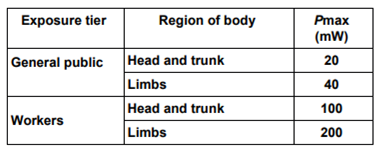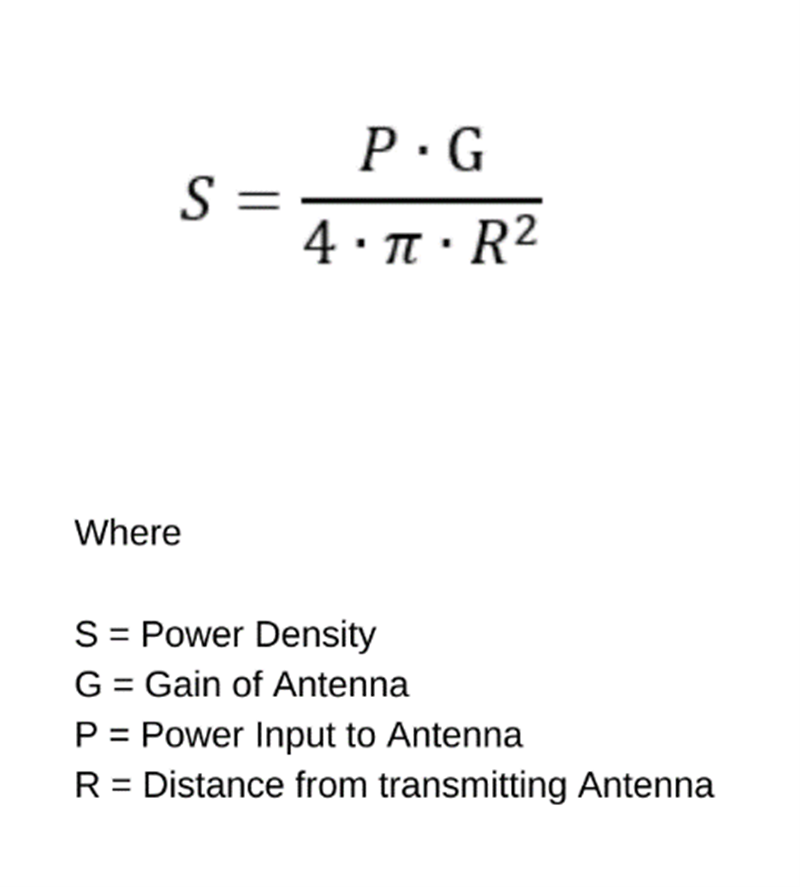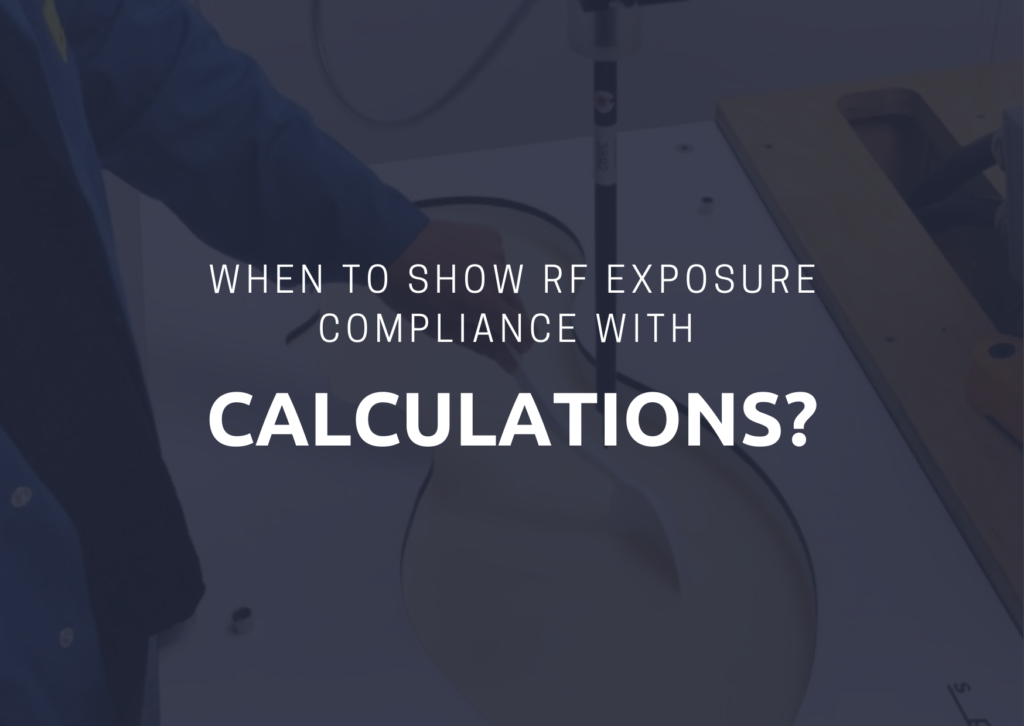- How to show RF exposure compliance
- Different methods to show RF exposure compliance
- Assessment of low power equipment
- Power Density Calculations
- Verkotan and RF exposure compliance calculations
- References
Radio frequency exposure compliance
Electromagnetic radiation is emitted from various natural and man-made sources. For example, electromagnetic radiation emitted from the sun keeps us warm and electromagnetic radiation emitted from the mobile phones enables wireless communication. As technology develops, we are increasingly being exposed to man-made electromagnetic radiation. To ensure a reliable and safe use of different wireless devices, the radio frequency (RF) exposure of these devices must be evaluated. The RF exposure compliance can be evaluated by testing or by calculations.
There are international and regional RF exposure requirements that are defined based on scientifically established health effects. The limits for RF exposure depend on the region where the device is being sold. The council of European Union determines the limits for EU, Federal Communications Commission (FCC) for USA and Innovation, Science and Economic Development Canada (ISED) for Canada.
Different methods to show RF exposure compliance
Overall, there are four methods to show radio frequency compliance. Two of the procedures are done by testing (SAR testing and EMF testing) and two of them are done by calculations (assessment of low power equipment -calculations and power density calculations). We have gone through all these four methods in our Four Ways to Show RF Exposure Compliance -article. If you are interested to find out when the RF exposure compliance evaluation is done by testing and compare these different methods, read that article. If you are interested only in cases in which RF exposure compliance can be shown with calculations, this is an article for you.
In this article we will only focus on the two methods to show the RF exposure compliance by calculations:
- Assessment of low power equipment -calculations
- Power density calculations.
1. Assessment of low power equipment
Assessment of low power equipment is one way to show RF exposure compliance by calculations. Assessment of low power equipment is possible to perform on low power devices. Standard EN 50663 defines maximum power levels, called PMAX exclusion levels for low power equipment. PMAX exclusion level means that if a device has lower or equal power levels as PMAX exclusion level, the RF exposure value of a device can be calculated instead of testing. Standard EN 50663 defines maximum power levels to be 20 mW over the 10 MHz to 300 GHz frequency range for the general public exposure. The standard EN 62479 defines the assessment methods for low-power electronic and electrical equipment. Below you see the PMAX exclusion levels defined by EN 50663:

PMAX exclusion levels defined by EN 50663
Assessment of low power equipment -calculations
Assessment of low power equipment -calculations could also be called theoretical SAR (Specific Absorption Rate) calculations. This is because in the EU, the assessment of low-power equipment uses the same limits that are used in SAR testing. For head and body, in Europe, the limits are 2 W/kg measured from 10g tissue volume and for limb SAR exposure, the limit is 4 W/kg and measured from 10g tissue volume. The limits for US are presented in FCC’s 447498 D01 General RF Exposure Guidance v06 -document and for Canada in ISED’s RSS-102 document.
These SAR calculations are always conservative. This means that by calculating the SAR value, the result might be a lot higher than the result would be with actual testing. For example, with calculations the SAR value of the same device might be 1W/kg but with testing, 0,2W/kg. Thus, if the calculated SAR value of the device is not within the SAR limits, it still might pass the actual SAR test.

How can I show that my device has lower or equal power as PMAX exclusion level (20 mW)?
There are four possible ways to show that your product’s power levels are within the required limits. The RF exposure can be calculated according to the EN 62479 standard if
- The device is inherently compliant with the applicable EMF exposure levels because of its physical characteristics, installation, and typical usage. Low-power device includes unintentional radiators which do not contain radio transmitters, such as audio/visual equipment, incandescent light bulbs, information technology equipment and multimedia equipment.
- The available antenna power and/or the average total radiated power do not exceed the low-power exclusion level because the input power level of the device in the relevant frequency range is so low.
- The available antenna power and/or the average total radiated power, limited by product standards for transmitters, is less than the low-power exclusion level.
- Calculations or measurements show that the available antenna power and/or the average total radiated power are less than the low-power exclusion level.
If you are able to show that your product’s power levels are lower or equal to PMAX levels, the RF exposure can be calculated according to the standard EN 62479. In cases where the product does not meet any of these requirements, the RF exposure evaluations must be performed according to other standards.
For example, the RF exposure compliance of Bluetooth headphones can typically be shown by assessment of low power equipment calculations.
2. Power density calculations
Another way to show RF compliance by calculations is power density calculations. There are two possible cases when power density calculations are possible to perform:
- When the device has radiating parts further away than 20 cm from a human body or head
- It operates over 6 GHz frequency.
For example, the RF exposure compliance of security cameras can be shown by power density calculations. This is because its radio is working further away than 20cm from a human body or head.
Power density means the power transmitted in the direction of propagation of the energy of an electromagnetic wave, through a normal surface, divided by the area of the surface.
Below you can see the equation for calculating the power density of a device. The equation does not consider the size of the antenna because the antenna is assumed to be a point source. Reference ideal isotropic antenna is used to be able to compare the performance of practical antennas: the power is assumed to radiate from the point evenly over the surface of the sphere of radius r.

Power density limits
There are regional limits to power density calculations. CE determines the limits for EU, FCC for USA and ISED for Canada.
- For Europe, the limit for plane wave equivalent power density is presented for EU Council Recommendation 1999/519/EC.
- In USA portable devices that operate at frequencies above 6 GHz can be evaluated in terms of the Maximum Permissible Exposure, MPE, limits specified in §1.1.310, according to 47CFR §2.1093 (Radiofrequency radiation exposure evaluation: portable devices)
- In Canada power density is the correct metric to assess RF exposure compliance of devices operating above 6GHz, according to the notice 2020-DRS0020
Power density calculations for devices operating above 6 GHz frequency, should be made at a minimum distance of 5cm from the radiating source. It is important that the device RF evaluation is done at maximum output power with maximum tune-up tolerance. Required operating modes and test configurations are used to show MPE compliance.
Verkotan and RF exposure compliance calculations
Let us take care of the measurement and you can focus on the processes that are the most relevant for you. We are fast, agile, and flexible partner with your RF exposure needs. In addition to the RF exposure compliance calculations, we offer RF exposure testing solutions: SAR testing and EMF testing. SAR testing must be done on radio devices that are used closer than 20 cm to the human head or body whereas EMF measurements are typically performed on low frequency devices.
We are always ready to help you to define the best way to show the RF exposure compliance of your device. Let’s schedule a meeting and find out the best test method for you!
References
https://www.who.int/peh-emf/meetings/6Simunic-Measurement_and_exp_assess_for_standards.pdf
https://www.law.cornell.edu/cfr/text/47/1.1310
https://www.ic.gc.ca/eic/site/smt-gst.nsf/eng/sf01904.html
https://www.law.cornell.edu/cfr/text/47/2.1093
https://www.ic.gc.ca/eic/site/smt-gst.nsf/eng/sf11198.html
https://www.icnirp.org/
https://www.ic.gc.ca/eic/site/smt-gst.nsf/eng/sf01451.html
If you need more information, Verkotan is always happy to provide more detailed information. We are always ready to make a proposal about how we can help you to verify the performance of your device in the global environment.
Follow our social media channels to keep up with the latest news in the world of wireless technology.
